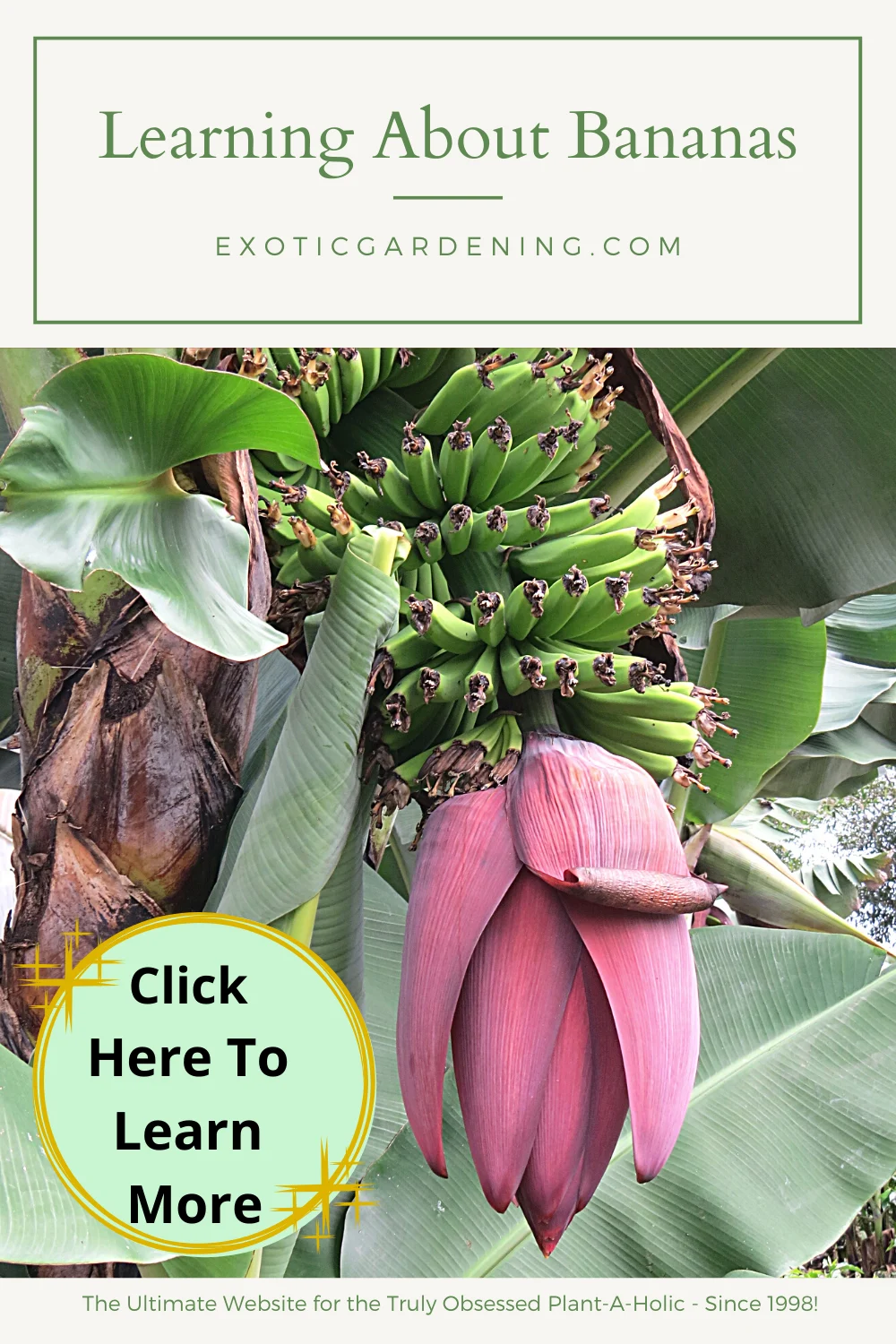The banana comes from the genus Musa and is one of the most popular foods in the world which is why learning about bananas is not only important, but fascinating.
Banana plants are available in both large and dwarf varieties, so there is one that is ideal for everyone regardless of where they live.
Dwarf varities of bananas do well in containers and will even fruit indoors as long as their needs are met.
Here is how to grow bananas.
Begin By Learning About Bananas Growing Requirements
All bananas require lots of water and light to thrive, regardless of their size.
While the dwarf varieties are easily grown in containers indoors, they will not fruit or flower if their needs are not met.
Most banannas require two years of being grown in the exact same spot, under the exact same conditions before they will even begin to flower.
A good idea if you are growing this plant indoors is to provide lots of moist air or have a humidifier close by.
This plant does not require any pruning, and should not be pruned.
Allow the dead leaves to fall off naturally.
How To Plant Your Banana Plant
Once you decide to try your hand at any of the Musa family, you should purchase a very large pot to plant your banana in.
They will grow quickly and need frequent repotting otherwise.
The longer the interveral between repotting the plant the better luck you will have of getting fruit.
Set the plant in a spot where it will have plenty of room for growth.
I have my banana in my greenhouse in a large pot with a grow light aimed right at it, that is left on continually.
The plant seems to be thriving, and seems to enjoy the extended hours of light.
Frequent fertilization is recommended, and you should increase your fertilizer during the summer months to make your plant a bit happier.
What Brown Leaves On A Banana Plant Mean
Brown leaves usually indicate that the plant is either too dry or not getting enough light.
When I first brought the plant home it was a sickly looking little plant with tons of brown leaves.
This condition seemed to continue for a number of weeks until I decided to add the additional light.
After that, my banana plant seemed to grow by leaps and bounds.
Cold Hardy Banana Plants
While most bananas extrememly dislike drafts and any type of cold weather, there are varieties that can withstand temptures of 30 degrees F. with wind, but not frost and still survive.
One such variety that can withstand these extreme temptures is the Orinoco which grow wild in the lower Rio Grande Valley in Texas.
Other varieties, such as Rajapuri, might experience leaf damage or some other type of physical damage, but still survive.
The best way to know what your particular variety of Musa can withstand is to research it, seperate a pup and test it for yourself.
After all, you never really know what will happen until you try it for yourself.
Different areas of your yard receive different degrees of wind, rain, and cold temptures depending on your sheltering conditions.
There are also particular varieties of bananas out there that can withstand temptures of 5 degrees F. with extended freezes and survive, although most likely these varieties will never produce fruit under these harsh conditions.
Here in Indiana, USDA Hardiness Zone ⅚, Musa basjoo will survive the winter in the ground outdoors as long as it is properly mulched, once the frost kills off the leaves in the late fall.
How To Get Your Banana To Fruit
Now, lets talk about how to get your Musa variety to produce fruit.
In order to get this to happen, you must provide at least two growing seasons of frost-free conditions and provide proper nutrition, especially in the early stages of growth.
The best cultivular to pick for this would be a dwarf variety with a fast maturing fruit.
The ideal banana mat consists of one plant that is fruiting, one that is half-grown, one that is a quarter grown, and the final one just emerging.
All of the offsets should not be left growing either because this drains the mother plant; however if they are at least a foot away from the main plant it is ok to let them grow.
With most varieties of Musa you will find that they readily produce offsets, especially during warmer months.
These can be used to produce more plants, or just simply cut-off and tossed into the compost pile.
How To Propagate Banana Plants
If you want to propagate this plant, do so by removing the suckers.
You can also grow bananas from seed, but you must keep the seeds moist and seed grown banana plants take longer to fruit or flower than ones started from suckers from mature banana plants.
How To Overwinter Your Banana
In the event that you cannot grow your banana in your house overwinter, it is best to dig it up in the fall, and store it.
Bananas should be kept in a cool, dark place over the winter as with your other bulbs if this is your plan.
When spring arrives, replant your banana in the ground outside.
I believe that you will find the banana plant a fascinating and easy to grow plant that produces masses of tropical leaves, and if you get the right combination of water, light, and fertilizer down, maybe even your own bananas!
Tropical Fruit And Foliage Plants
Tropical Plants For Medium To High Light
Check out these awesome tropcial plants for medium to high light that make wonderful, easy to care for houseplants.
Caring for Indoor Palm Plants: Tips for Thriving Green Beauties
Discover expert tips for caring for indoor palm plants, ensuring their vitality and adding a touch of tropical elegance to your space.
How To Grow Cinnamon
Learn how to grow cinnamon from seed or cuttings. Cinnamon trees do well as houseplants even though they can get rather large.
How To Grow And Harvest Pineapple From Home
Learning how to grow and harvest pineapple is a fun project that anyone in any climate can experience as long as they are patient.
Colorful Foliage Plants
Try these colorful foliage plants in your garden this summer and then bring them indoors during the winter to brighten up your home decor.
Easy Exotic Houseplants: Tropicals That Thrive Indoors in Containers
Tropical plants are the most beautiful, easy to grow indoor houseplants. Start growing exotic houseplants today that fruit and flower!
Eucalyptus Growing Indoors: Tips and Troubleshooting Guide
Discover the art of eucalyptus growing indoors for year-round beauty and fragrant cut foliage in your flower arrangements.
My Theobroma cacao Story
I've had a love affair with growing chocolate for over twenty years, so I wanted to share my Theobroma cacao story with all of you.
Scented Grass Adds Natural Fragrance To The Home Or Garden
Scented grass is one way to add scent to your garden or even your home. Best of all, they look pretty, smell great and have practical uses.
The Enigmatic Elegance: A Comprehensive Guide to Philodendron Florida Ghost Care
Elevate your indoor gardening with our guide to Philodendron Florida Ghost care, propagation, and maintenance tips.
Incorporating Bold And Exotic Plants Into Your Landscape
Discover the allure of bold and exotic plants for your garden in this comprehensive guide. Transform your landscape today!
Variegated And Other Interesting Plants: Elevate Your Space with Nature's Painted Wonders
Explore the world of variegated and unique plants, adding vibrant beauty and intrigue to your indoor oasis.
How To Grow Tropical Plants
Growing tropical plants - also known as houseplants - indoors is fun and enjoyable plus many of them clean the indoor of pollutants.
It is easy to grow exotic looking plants that produce tropical fruit and colorful flowers in a pot in your living room or office.
Many of these plants are easy to start from seed and I share with you five plants that I recommend for indoor growing.
I also share with you why growing your own tropical fruit saves money.
In this video you will learn:
How to bring tropical plants indoors at the end of summer
How to grow tropical plants indoors
How to protect and overwinter tropical plants outdoors in cold climates
How to propagate tropical plants
How to water tropcial plants
How to grow topical plants in a greenhouse

















